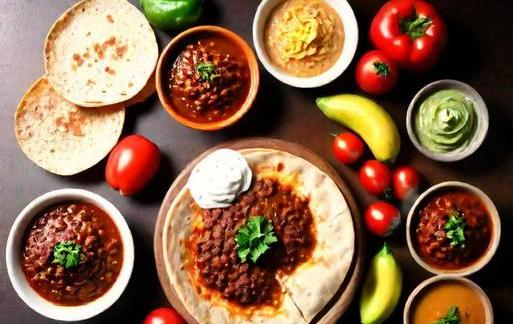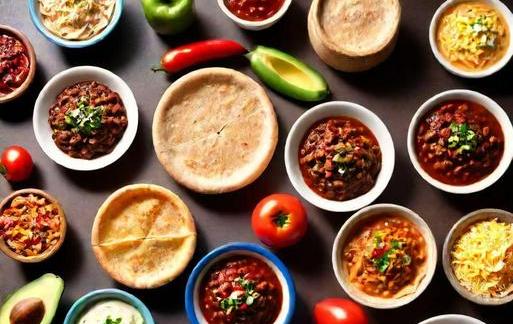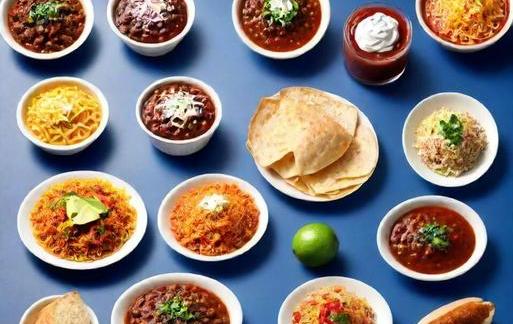- You are here:
- Home »
- Food
- » [REVEALED] Hispanic Foods That Start With P
[REVEALED] Hispanic Foods That Start With P
Note: This page contains affiliate links.
As an Amazon Associate, I earn from qualifying purchases when you click on the link, but you are not charged extra.
Hispanic cuisine is a vibrant and diverse tapestry of flavors, colors, and textures, reflecting the rich cultural heritage of the Spanish-speaking world. From the robust spices of Mexico to the sophisticated flavors of Spain, Hispanic foods offer a culinary adventure for the senses. In this exploration, we focus on a specific letter of the alphabet – P. Get ready to embark on a gastronomic journey as we delve into a comprehensive list of Hispanic foods that start with the letter P.
Contents
List Of Hispanic Foods That Start With P

1. Paella
Originating from the Valencia region in Spain, Paella is a delectable one-pan dish that showcases the perfect fusion of flavors. This iconic Spanish rice dish often includes a medley of seafood, chicken, rabbit, and a symphony of spices such as saffron and paprika. The rice absorbs the rich broth, creating a savory explosion in every bite.
2. Pupusas
Hailing from El Salvador, Pupusas are thick, handmade corn tortillas filled with various ingredients like cheese, beans, pork, or loroco, a native Central American flower bud. Grilled to perfection, these stuffed delights are often served with curtido, a pickled cabbage relish, and a side of tomato salsa. Pupusas have become a beloved street food not only in El Salvador but also in many other parts of Central America.
3. Pan Dulce
Pan Dulce, or sweet bread, is a diverse category of Hispanic baked goods that spans across many countries. Mexican Conchas, Spanish Ensaimadas, and Cuban Pastelitos are just a few examples. These sweet treats come in various shapes and sizes, each with a unique combination of ingredients like sugar, cinnamon, anise, and sometimes filled with custard, fruit preserves, or sweet cream.
4. Papas Rellenas
A popular dish in several Latin American countries, Papas Rellenas are stuffed potatoes that are often deep-fried to golden perfection. The filling can vary, with options like seasoned ground beef, black beans, cheese, or a combination of these. Served with a side of salsa or aioli, Papas Rellenas are a delightful and satisfying snack.
5. Pico De Gallo
While Pico de Gallo may seem simple, its freshness and flavor make it a staple in Hispanic cuisine, particularly in Mexican dishes. This salsa is a refreshing mix of diced tomatoes, onions, cilantro, jalapeños, and lime juice. Whether as a topping for tacos or a dip with tortilla chips, Pico de Gallo adds a zesty kick to any dish.
6. Pernil
In Puerto Rican cuisine, Pernil refers to slow-roasted pork shoulder, seasoned to perfection with a blend of herbs and spices. The result is tender, succulent meat with a crispy outer layer known as "cuero." Pernil is often the centerpiece of festive occasions and celebrations, showcasing the mastery of traditional Puerto Rican culinary techniques.
7. Picadillo
Picadillo is a versatile and savory ground meat dish that is a culinary gem across many Hispanic cultures. While the specific ingredients may vary, a typical Picadillo includes ground meat, tomatoes, onions, garlic, and a mix of spices. The sweet and savory combination is often enhanced with ingredients like raisins, olives, and capers. Picadillo is served with rice or used as a filling for empanadas.
8. Plantains
A beloved staple in Hispanic cuisine, plantains are versatile fruits that can be prepared in various ways. Whether fried, boiled, or baked, plantains are a delicious side dish or snack. Tostones, for example, are twice-fried green plantains popular in many Caribbean countries. Maduros, on the other hand, are sweet, ripe plantains that are fried until caramelized, offering a delightful contrast to savory dishes.
9. Pollo Asado
Pollo Asado, meaning grilled chicken, is a flavorful and juicy dish enjoyed in many Hispanic communities. Marinated with a blend of citrus, garlic, herbs, and spices, the chicken is grilled to perfection, resulting in a smoky and aromatic flavor. Pollo Asado is often served with rice, beans, and a side of salsa.
10. Pozole
Pozole is a traditional Mexican soup that boasts a rich history dating back to pre-Columbian times. The main ingredients include hominy corn and meat, usually pork or chicken, cooked to create a hearty and flavorful broth. The dish is garnished with a variety of toppings like radishes, cabbage, avocado, and lime, allowing each diner to customize their bowl to their liking.
11. Parrillada
A feast for meat lovers, Parrillada is a sizzling platter of grilled meats, often featuring an assortment of beef, pork, chicken, and chorizo. This Argentinian barbecue delight showcases the art of open-flame cooking, infusing the meats with a smoky and charred flavor. Served with chimichurri sauce, Parrillada is a celebration of the carnivorous side of Hispanic cuisine.
12. Pulpo A La Gallega
Hailing from the Galicia region in Spain, Pulpo a la Gallega is a tantalizing dish featuring tender octopus seasoned with paprika, olive oil, and sea salt. The octopus is typically boiled until tender and then sliced into bite-sized pieces. This dish showcases the simplicity and quality of Galician seafood, offering a taste of the Atlantic Ocean on a plate.
13. Plátano Maduro Con Queso
A popular dessert or snack in many Hispanic countries, Plátano Maduro con Queso features ripe plantains topped with cheese. The plantains are typically fried until golden and sweet, creating a caramelized exterior that pairs perfectly with the salty and creamy cheese. This delightful combination of sweet and savory is a testament to the creative and harmonious nature of Hispanic cuisine.
14. Panela Cheese
Panela Cheese, a fresh and mild Mexican cheese, is a versatile ingredient used in a variety of dishes. Its soft texture and mild flavor make it suitable for grilling, crumbling over salads, or stuffing into chiles. Panela cheese’s ability to absorb flavors and complement other ingredients makes it a popular choice in many Mexican recipes.
15. Pambazo
A Mexican street food classic, Pambazo is a type of sandwich featuring a soft white roll dipped in a red guajillo pepper sauce and filled with chorizo, potatoes, lettuce, and crema. The roll is then grilled until crispy, creating a unique texture that contrasts with the savory and spicy filling. Pambazo is a flavorful and satisfying choice for those seeking a taste of authentic Mexican street cuisine.
From the iconic Paella to the comforting Pozole, Hispanic foods that start with the letter P offer a diverse and delectable array of flavors and textures. Whether you’re exploring the rich traditions of Spain, savoring the street food delights of Mexico, or indulging in the culinary treasures of Puerto Rico, the Hispanic culinary landscape is a journey worth taking. As we conclude our exploration of these mouthwatering P-starting delights, it becomes evident that each dish is a testament to the cultural richness and culinary creativity embedded in Hispanic gastronomy. So, the next time you embark on a culinary adventure, consider exploring the world of Hispanic foods that start with P – your taste buds will undoubtedly thank you for the delightful journey.
Significance

The Hispanic culture boasts a diverse and vibrant culinary heritage, where flavors, aromas, and traditions intertwine to create a unique gastronomic experience. In this exploration, we delve into the realm of Hispanic foods that start with the letter "P," uncovering the richness of this cuisine and the significance it holds in the hearts of millions.
Hispanic cuisine is a mosaic of influences, shaped by the amalgamation of indigenous, African, European, and Asian culinary traditions. The letter "P" in Hispanic foods represents a plethora of dishes that not only satiate the palate but also narrate stories of history, migration, and cultural exchange. From savory to sweet, spicy to mild, the foods beginning with "P" offer a diverse array of flavors that mirror the diversity of the Hispanic community.
Category-Related

**1. ** Pupusas: A Salvadoran Delicacy
Originating from El Salvador, pupusas are a quintessential part of Hispanic cuisine. These thick, handmade corn tortillas are filled with various ingredients such as cheese, beans, and meat. Pupusas are griddled to perfection, resulting in a crispy exterior and a flavorful, gooey interior. Typically served with curtido (a cabbage slaw) and salsa, pupusas are a delicious representation of comfort food in Hispanic households.
**2. ** Paella: The Spanish Culinary Icon
Hailing from the Valencia region of Spain, paella is a globally acclaimed dish that has become synonymous with Spanish cuisine. A savory rice dish, paella is traditionally cooked in a wide, shallow pan, allowing the rice to caramelize at the bottom. The key ingredients include saffron, vegetables, and a variety of proteins such as chicken, rabbit, seafood, or a combination of these. The result is a flavorful, aromatic masterpiece that captures the essence of Spanish culinary prowess.
**3. ** Pozole: A Mexican Homage To Tradition
In Mexico, pozole is a beloved dish that embodies the country’s rich history and cultural celebrations. This hearty soup features hominy (dried corn kernels that have been treated with an alkali) and meat, often pork or chicken. The broth is seasoned with a blend of chilies and spices, providing a depth of flavor that is both comforting and invigorating. Pozole is traditionally served during festive occasions, making it a staple in Mexican households during celebrations and gatherings.
**4. ** Picadillo: A Ground Meat Delight
Picadillo is a ground meat dish that transcends borders within the Hispanic culinary landscape. While variations exist across different regions, the common theme is finely ground meat, often beef or pork, cooked with a medley of ingredients such as tomatoes, onions, garlic, and spices. The result is a savory and slightly sweet mixture that can be served with rice, tortillas, or used as a filling for empanadas. The adaptability of picadillo showcases the versatility embedded in Hispanic cuisine.
**5. ** Plantains: A Versatile Delicacy
While not a dish in itself, plantains are a staple ingredient in Hispanic cuisine. These starchy bananas can be prepared in various ways, offering both sweet and savory options. In their savory form, plantains are often fried to make tostones or maduros, providing a delightful crunch and a hint of sweetness. In contrast, when ripe, plantains can be used in desserts, adding a natural sweetness to dishes like plátanos en tentación. The versatility of plantains highlights their significance in Hispanic kitchens across the globe.
Common Themes
The Hispanic foods beginning with "P" share common themes that echo throughout the culinary landscape. One such theme is the emphasis on fresh, locally sourced ingredients. Whether it’s the vibrant array of vegetables in a pupusa or the aromatic saffron-infused rice in paella, the commitment to quality ingredients is a common thread that binds these dishes.
Another theme is the celebration of communal dining. Many Hispanic dishes are designed to be shared among family and friends, fostering a sense of unity and togetherness. This communal aspect is especially evident in the preparation and consumption of pozole, where large pots are often crafted to accommodate gatherings during festive occasions.
Furthermore, the influence of indigenous flavors is a prevalent theme in Hispanic cuisine. The use of native ingredients, traditional cooking methods, and ancient recipes passed down through generations contribute to the unique flavors and textures found in dishes like picadillo and pupusas.
Interesting Facts
**1. ** Papaya: The Tropical Delight
While exploring Hispanic foods that start with "P," it’s intriguing to note that papaya, although originating from tropical regions in the Americas, is widely used in Hispanic cuisine. The vibrant orange fruit is not only enjoyed fresh but is also incorporated into refreshing beverages, desserts, and salsas. Its sweet and slightly musky flavor adds a delightful twist to many dishes, showcasing the adaptability of ingredients in Hispanic cooking.
**2. ** Pimientos De Padrón: The Spanish Roulette
In Spain, a popular tapa known as pimientos de padrón involves frying small, green peppers and serving them with sea salt. The interesting twist is that while most of these peppers are mild, there’s the occasional fiery one that adds an element of surprise to each bite. This culinary roulette has become a playful tradition, with diners eagerly anticipating the heat in this simple yet thrilling dish.
**3. ** Pernil: The Slow-Roasted Tradition
Pernil, a slow-roasted marinated pork shoulder, is a festive dish often associated with Hispanic celebrations, especially during holidays. The preparation involves marinating the pork in a blend of garlic, herbs, and spices before slow-roasting it to perfection. The result is succulent, flavorful meat with a crispy outer layer, making pernil a centerpiece of joyous occasions in Hispanic households.
**4. ** Pan Dulce: The Sweet Bread Delight
Pan dulce, or sweet bread, is a beloved Hispanic treat that encompasses a wide variety of baked goods. From conchas to cuernos, these sweet delights are often enjoyed with coffee or hot chocolate. The intricate designs and diverse flavors of pan dulce reflect the creativity embedded in Hispanic baking traditions, making it a delightful part of daily life in many Hispanic communities.
Conclusion
In the tapestry of Hispanic foods that start with "P," we discover a world of flavors, traditions, and shared moments. From the savory embrace of pupusas to the communal celebration of pozole, each dish tells a story of heritage and resilience. The significance of these foods goes beyond the ingredients; it is a celebration of culture, family, and the enduring spirit that binds communities together. As we savor the diverse array of Hispanic dishes, we not only indulge in a culinary adventure but also pay homage to the vibrant tapestry of a culture that continues to enrich the world with its gastronomic treasures.


